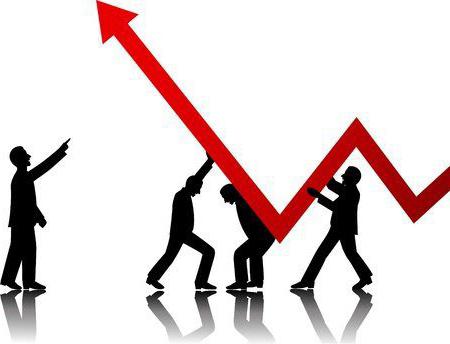The modern economy dictates its own rules, which include the mandatory requirement to continuously increase the productivity of workers. Without high indicators in this area, no one will be able to do business with high profit. But what can be done to increase labor productivity?
Performance Types
 Before discussing the improvement of the performance of the company’s employees, it would not be out of place to recall the types of productivity. So, it is divided into several subtypes:
Before discussing the improvement of the performance of the company’s employees, it would not be out of place to recall the types of productivity. So, it is divided into several subtypes:
- Actual.
- Cash.
- Potentially possible.
So, let's discuss each variety.
Actual, contrary to popular belief - this is not the productivity of labor that is fixed at some enterprise at the current moment in time. This is the effectiveness of the work in relation to the number of goods or services that were issued / rendered by the company.
Cash - shows what real performance can be achieved if all costs and downtime are completely eliminated. It should be noted that this type is practically unrealizable in practice, but it can be considered a kind of standard to which we must strive, and with which we should compare the actual results of labor productivity in production.
Potentially possible In general, it is very similar to the previous one. It also discusses the possible performance that can be achieved with the complete elimination of all negative factors, the complete updating and replacement of all factors and means of production.
What are the criteria for evaluating labor productivity in production?
To correctly identify the real value of labor efficiency of workers, you need to know about its most important indicators. In total, exactly seven criteria are distinguished:
- Performance indicators. How efficiently the enterprise can achieve its goals, what are its production capabilities.
- Profitability. As the name implies, the so-called justified and efficient use of the resources available to the enterprise.
- Quality. Correlation between investors' expected production and actual results.
- Profitability ratios. Defined as the ratio between actual costs and almost received net profit.
- Actually performance. The ratio of the volume of labor to the volume of products received / services rendered.
- The quality of working life. How well organized is the work process and the rest of workers. Anonymous questions with suggestions and comments addressed to company management especially help to evaluate this aspect.
- Innovation Availability and quantity of innovations. It is desirable that statistics be kept at the same time showing the ratio of labor and profits before and after the introduction.
 Manufacturing factors affecting the manufacturing process
Manufacturing factors affecting the manufacturing process
Many experts agree that two main factors have the greatest impact on productivity:
- Qualification. The higher it is, the more an employee can achieve per unit of time. It is widely believed that the necessary personnel can be "grown" within the company itself, but this is not entirely true. In some cases, this statement is true, but practice shows that attracting ready-made professionals significantly increases production capabilities.
- Time management. Even a competent professional will waste work time if he does not possess the ability to distribute it correctly. Today, there are many training methods that, when implemented in production, can significantly increase the profitability of your company.
It should be noted here that there are other rules that are automatically associated with the first two recommendations:
- Correct setting of adequate goals.
- Predefined priorities for their achievement.
- Planning of business in terms of a specific working period.
- Correct employee motivation = increase in labor productivity. This is an axiom.
Domestic business is particularly distinguished by the latter criterion, and not for the better. For some reason, the leaders of many enterprises consider the threat of dismissal to be the best “motivation”. It should be remembered that the modern market of specialties is already playing "all the way." Simply put, a worker in a popular specialty (technician, engineer, IT specialist) will always find work, but it will be very difficult for the company's management to provide the company with an adequate replacement.
So the best motivation, as required by the capitalist system, is financial. There is a bonus for the quality performance of work - there is the employee’s return and his desire to increase the pace of production. Permanent penalties to increase labor productivity, if they help, then not for long. Inevitably, a massive staff turnover will inevitably begin, due to which many companies in the end find themselves, if not on the verge of bankruptcy, then close to that.
 In addition, the separation of work processes and activities has always been important for proper and efficient operation. For example, you should separate sales and actual cash flow plans for the same reporting period. For example, an employee could sell 100 machines, but full payment for them will come only after six months or a year, since they were bought on lease or on similar terms. When labor motivation based on profit for a short period of time is used, it is ineffective.
In addition, the separation of work processes and activities has always been important for proper and efficient operation. For example, you should separate sales and actual cash flow plans for the same reporting period. For example, an employee could sell 100 machines, but full payment for them will come only after six months or a year, since they were bought on lease or on similar terms. When labor motivation based on profit for a short period of time is used, it is ineffective.
How can performance be manifested?
The saving of working time is indicated by a reduction in labor costs per unit of output with a general increase in the number of manufactured goods / services rendered. The most important thing is to reduce labor costs as much as possible, but not to the detriment of the quality of the products. In this regard, the management of the enterprise always needs to remember that it is better to hire one highly qualified employee with a decent salary than hiring ten low-paying employees who together will produce fewer products. These are the simplest methods for increasing labor productivity, which for some reason are ignored.
One important rule follows from this - a constant desire to improve the quality of the created product while (if possible) maintaining the current volume of output or increasing it. The modern economy in this area dictates special rules - the desire for maximum mechanization of production, the introduction of more automated lines into the production process with a reduction in the number of living employees.
Reduced work time is also a positive indicator of increased labor productivity. This is achieved by compaction of the work process, the introduction of new methods of production and processing of raw materials, which saves employees time and allows them to focus on the work process. At the same time, a productive, consistent increase in productivity can be achieved, which in other conditions can be difficult or impossible to achieve.
The main factors indirectly affecting labor productivity
There are two groups of factors directly affecting labor productivity and the quality of products manufactured by an employee: external and internal. External should include:
- Natural factors. If people work in conditions of extremely high or low temperatures, then high labor productivity can not be expected.
- Political. If social stratification is expanding in society, when 1% of the population receives income from the results of other people's work, then the motivation of workers also tends to zero.
- General economic factors, which include the value of taxes, the presence or absence of benefits, support from the state, etc.
The following can be attributed to internal factors of increasing labor productivity:
- Introducing the latest technologies and other achievements of scientific and technological progress into industrial practice.
- Timely correction of the company's structure, aimed at optimizing internal processes.
- Improving managerial functions.
- The correct motivation of labor, the distribution of time of production processes.
Labor productivity visualization
 Suppose that the situation with labor productivity in the enterprise leaves much to be desired. The situation can turn the tide, visualizing the management of this process. Here, in the form of graphs, the efficiency and all violations at each site are displayed. It is important to identify those correlations that affect the performance indicators of each shift.
Suppose that the situation with labor productivity in the enterprise leaves much to be desired. The situation can turn the tide, visualizing the management of this process. Here, in the form of graphs, the efficiency and all violations at each site are displayed. It is important to identify those correlations that affect the performance indicators of each shift.
All this should be displayed in parallel with the graphs, which indicate the amount of consumed resources and labor. The easiest way is to show in green the standards that fit into the norm or “interrupt” it, and in red, respectively, those that did not meet the norm. So you can quickly understand at what stage in the workflow an error creeps in. It is important that the immediate supervisor of the workers discuss these issues with them before each shift. This approach in some cases allows you to solve the problem on the spot, as well as to determine the reserves for increasing labor productivity (determines free time, gaps between the processes of release of goods).
Labor leaders
Note that information stands can and should contain other sections, the main of which will be those that display information about the most distinguished employees. A simple psychological technique - at the end of the shift, immediately enter the results in the table, and when receiving a new batch of workers, voice these numbers. They will surely have a desire, if not to exceed, then, at least, not to lag behind their comrades. Simply put, stands bring an element of competition into the production process and increase management efficiency.
Scientific methods for evaluating performance
Of course, before taking measures aimed at increasing labor productivity, it is necessary to evaluate this productivity as accurately as possible. For this, science recommends using two indicators:
- The complexity of the process.
- The direct output.
It is known that these indicators are inversely related to each other. Production can be defined as the ratio of costs and volume of output. The following factors can be indicators of the volume of production:
- Cost amount of manufactured and already shipped products.
- Gross goods and all other similar indicators. The volumes that were issued at related enterprises during the reporting period may also be taken into account.
- You should also take into account indicators obtained without taking into account raw materials, energy, depreciation cost of equipment.
 Costs can be understood as the size of labor costs, as well as total costs. But still, the most indicative in this regard is the complexity.Increasing labor productivity in the enterprise is inversely proportional to labor intensity. The higher it is, the less production one worker or the whole enterprise will ultimately be able to make. Thus, one should always strive for its maximum reduction.
Costs can be understood as the size of labor costs, as well as total costs. But still, the most indicative in this regard is the complexity.Increasing labor productivity in the enterprise is inversely proportional to labor intensity. The higher it is, the less production one worker or the whole enterprise will ultimately be able to make. Thus, one should always strive for its maximum reduction.
Production mechanization
For some reason, some business leaders believe that labor intensity can be “defeated” by tightening up working time and not investing in mechanization and technical development of production at all. This approach is vicious and only leads to an increase staff turnover. Mechanized ways to increase labor productivity have many advantages:
- You can establish a direct relationship between production volumes and labor costs for a specific time period.
- It allows to exclude variations in work efficiency depending on external factors (climate, work regime).
- It is possible to more accurately compare the performance indicators of labor in different workshops and production lines. Again, without taking into account external factors.
- Finally, you can clearly identify potential reserves to increase.
And now we’ll finally talk about the methods of increasing labor productivity, starting from all the above facts.
Key Productivity Techniques
 The following methodologies and methods are scientifically substantiated, thanks to which the productivity of the work process can be seriously raised:
The following methodologies and methods are scientifically substantiated, thanks to which the productivity of the work process can be seriously raised:
- Strengthening the material and technical base. If a worker has a machine breakdown every 20 minutes, he will not be able to physically do many parts.
- Modern management tools and increasing the personal responsibility of middle managers. It often happens that managers mysteriously receive bonuses for the successes of production, to which they are weakly involved, and completely avoid responsibility for the failure of their own innovations. This seriously drops the motivation of workers and their desire to work (it is necessary to increase management efficiency).
- Continuous analysis of production processes based on graphical stands (we already spoke about them). So you can easily identify all the factors that increase labor productivity and problems that lead to a significant drop in productivity.
- Each employee should have before his eyes his job description. It often happens that the immediate superiors prefer to “plug” workers into the production holes created by their own miscalculations. Each employee must know exactly what he should do, and where exactly to report violations of the work schedule.
- Improving the organization of work and rest of employees. A person will have a much better rest not in a tattered smoking room, but in a specially equipped room where you can sit and watch TV, listen to the radio, drink tea, etc.
- Motivation. Each employee should know that it is he, and not a dozen of his superiors, who will receive a bonus for the proposed modernization of the work process that will lead to real profits of the enterprise.
- Again, increasing employee productivity is possible due to his direct participation in the elimination of urgent problems. Often, machine operators are better aware of the reasons for the decline in production than middle managers who have never been to production shops at all.
- All indicators of labor efficiency should be regularly evaluated and announced. They should not be dry figures of reports that are of interest only to investors.
All the ways to increase labor productivity described by us are simple, but they are often forgotten. This affects the volume of profit and leads to the departure of the most valuable production personnel.
Production and HR reserves
We discussed the basic methods of increasing labor productivity. And now you need to talk a little about production reserves that will help solve this problem with maximum benefit.
As it is easy to understand, this term means all the funds available on the balance sheet of the enterprise (machines, machine tools, computers), the efficiency of which can be improved. This type of reserves is divided into two types: current and prospective. Accordingly, “current” means those capacities that the enterprise already has. For the “activation” of promising ones, it will be necessary to partially reconfigure production and introduce new technologies. However, in some cases it is enough to optimize the program on the machine so that the machine runs faster.
And what is a personnel reserve? This is the most valuable thing that any enterprise has - the people who work there. As in the previous case, reserves of this type are divided into current and prospective. Accordingly, the current - this is the staff that the company currently has. By “prospective”, here, we mean not only those people who have not yet been hired, but also those who, when sent to continuing education courses (for example), can bring the company even more profit.
 In addition, the personnel reserve is a material stimulation of the work of employees, their timely promotion, rewarding with the titles of "honorary employee", etc. Without any exaggeration, we can say that these simple measures in other cases increase labor productivity by 60-73%! Everything is simple here. A motivated and loyal person will put all his strength and skills into the development of his native enterprise, which can be unrealistic in other ways.
In addition, the personnel reserve is a material stimulation of the work of employees, their timely promotion, rewarding with the titles of "honorary employee", etc. Without any exaggeration, we can say that these simple measures in other cases increase labor productivity by 60-73%! Everything is simple here. A motivated and loyal person will put all his strength and skills into the development of his native enterprise, which can be unrealistic in other ways.






